Submit Chapter news to Beacon Co-Editors and OES Chapter Coordinator
Argentina Chapter
OES special session on ARGENCON 2020
Reported by Gerardo Acosta, Argentina Chapter Chair

From the 1st to the 4th, the Argentina Section’s biennial conference was held during the past December. In cooperation with its General Chair, Dr. Carlos Alejandro Pérez, and the Program Committee Chairs, Dra. María Daniela López De Luise and Dr. Ricardo Armentano, the IEEE OES Argentina Chapter members organized a special session with the presentation of some papers about related ocean technology topics and three excellent talks of our program of Distinguished Lecturers. With about 60 attendees on average for each of them, the first talk was a pleasant description of the insights gained from a decade of autonomous marine systems development at the University of Sydney’s Australian Centre for Field Robotics, led by Stephan Williams. During this time, this team has developed and deployed numerous underwater vehicles and imaging platforms in support of applications in engineering science, marine ecology, archaeology, and geoscience. They have successfully collected millions of images of the seafloor around Australia and made these available to the scientific community through online data portals developed by the facility and affiliated groups. These observations are providing important insights into the dynamics of key ecological sites and their responses to oceanographic condition changes through time. They have also contributed to expeditions to document coral bleaching, cyclone recovery, submerged neolithic settlement sites, ancient shipwrecks, methane seeps, and deepwater hydrothermal vents.

The second talk was an amusing lecture given by John Potter about underwater acoustic communications. He explained how, in the last decades, technological advances in autonomous vehicle engineering, control theory, Global Positioning, battery chemistry, computational power, memory, advanced materials, additive manufacturing, and so many other fields have combined to enable the dream of sampling the ocean to gather as much information as possible. But to empower these new autonomous vehicles, they need to communicate, even more than that, they need to collaborate through an Internet of Underwater Things. This can only be achieved over significant distances by acoustic communications. Thus, this formerly highly specialized field, initially developed almost exclusively for military purposes, has now been catapulted into the forefront of necessary enabling technologies for the future. Underwater communications and networking is now a critical enabling technology for the future of maritime activities, just as WiFi and the internet has become an indispensable foundation for everything we do on land and in the air and space above. Maritime robotics is a game-changing disruptive technology wave that, like a tsunami, is drawing breath to swamp everything we thought we knew about how to operate in the largest and most important biosphere on our planet. And this tsunami is founded on underwater acoustic communication and networking.
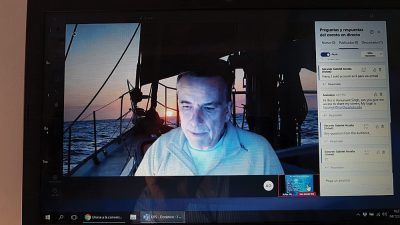
The third talk was a very interesting conference given by Hanumant Singh, about his enormous experience in marine and polar robotics. Using amazing examples from Marine Robotics, he described some of the roots of the current efforts of his team to use robots in areas with strong social relevance – Fisheries, Coral Reef Ecology, Oil Spills, and Marine Geology in the Arctic, and understanding the role of climate change in the Antarctic and how that is affecting the ecology of the Southern Ocean. He showed how these applications had motivated fundamental analysis in the areas of SLAM, Imaging, and Computer Vision and Autonomy. Finally, he gave us a look to the future to provide a vision of the challenges we will face in the coming decades.1
Ref.1: the summaries of the talks were extracted from the abstracts of them given by the lecturers.
Providence Chapter
Reported by David Leslie, OE22 Chapter Secretary
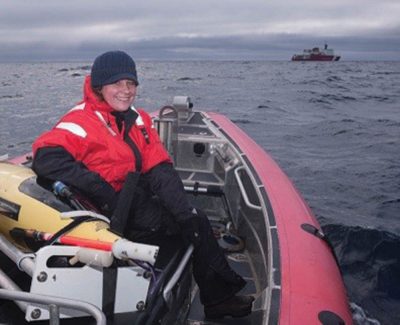
On March 11, 2021, Lora J. Van Uffelen, Ph.D., delivered a technical talk to the Providence Section, Ocean Engineering Chapter, titled “Global Positioning Systems: Over Land and Under Sea.” Dr. Van Uffelen is an Assistant Professor in the Ocean Engineering Department at the University of Rhode Island, Narragansett, RI, USA, where she teaches undergraduate and graduate classes and directs the Ocean Platforms Experiments and Research in Acoustics Lab (OPERA). Her research focus is on long range acoustic propagation and she has extensive cruise experience. This was our chapter’s 3rd online presentation made remotely via Zoom during the COVID-19 pandemic.
Global Navigation Satellite Systems (GNSS) provide reliable positioning for the land, air, and space domains using electromagnetic signals, but are not useful below the sea surface due to attenuation. Sound on the other hand can travel long distances underwater and can be used for positioning of underwater vehicles, sensors, and even animals. In her talk, Prof. Van Uffelen provided an overview of different methods for determining position underwater using acoustics and explored the challenges and potential for the implementation of a large-scale acoustic positioning system underwater. Many of the topics discussed were also described in her recent feature article in Acoustics Today (1).
GNSS has a long history of development both in the USA (GPS) and internationally (GLONASS, BEIDOU, GALILEO). The GPS project itself started in 1973 with the NAVSTAR satellite being launched in 1978 and the full 24 satellite constellation becoming operational in 1995. Coverage has improved over the years. Prof. Van Uffelen highlighted the early contributions of Gladys Mae West and others who generated databases to make localization calculations. The GPS system grew out of military applications such as localization, tracking, navigation, mapping and timing. The system was designed with submarines in mind, but it only works at the sea surface. Oceanographic platforms, which use GPS, include Argo floats, buoys off Block Island, Seagliders with GPS antenna and the Liquid Robotics wave glider, among others.
In the absence of GPS, subsea systems have navigated using dead reckoning or MEMS-based inertial measurements. Doppler velocity logs can be used close to the bottom. Underwater acoustic positioning systems have operated using long, short and ultra-short baselines. Long baseline systems employing four transponders on the seafloor, for example, are effective at ranges up to a few kilometers. Short baseline systems may use transponders on different ends of a surface vessel. Ultra-short baseline, making use of small transponder arrays, may also be deployed on vessels. These systems use acoustical signals in the tens of kHz.
Long-range applications make use of sound propagation through the SOFAR channel where acoustical energy, trapped at depths near the sound speed minimum, does not interact with the bottom. This enables sound propagation to very long distances. Swallow floats are neutrally buoyant oceanographic floats equipped with acoustic pingers. While drifting at depths in the SOFAR channel theses devices have been tracked using near shore SOSUS hydrophone arrays at distances up to 1000 km. A variation on this technology, so-called RAFOS floats, reverses the process by putting receivers rather than sound sources on the floats. This allows for a smaller float. Such floats have been used to help map ocean circulation. Initially these systems used narrow band, low-frequency sound sources (500-600 Hz). More recently, the use of broadband sources (~50 Hz bandwidth in the 100 – 200 Hz range) has enabled higher resolution of arrival time and better estimation of both travel time and receiver location. Estimates of travel time over long path lengths can also be used to invert for average sound speed, or to map sound speed if many travel paths are available in tomographic experiments.
Prof. Van Uffelen illustrated these principles using results she obtained in the Ocean Acoustic Tomography Experiment in the Philippine Sea: 2010-2011. In that experiment six sources were used to broadcast broadband signals (center frequency= 250 Hz, 100 Hz bandwidth) to four Seagliders. The sources and receivers could all transmit to each other. When their positions were known it was possible to invert for sound speed and infer ocean temperature. The localization of underwater vehicles at long ranges is an active area of research. Scattering of acoustic signals due to internal waves makes peak matching and arrival time estimation more difficult. Automatic peak matching is now being performed using machine learning techniques.
In the Canada Basin Acoustic Propagation/Glider Experiment, acoustic Seagliders were deployed in August/September of 2016 and 2017. The gliders circulated in the area, listening to 250 Hz sources at distances of up to 250 km. There is no deep SOFAR channel in the Arctic Ocean, but there is a so-called Beaufort duct near the surface, within which acoustic rays bounce back and forth. Near real-time range estimates were computed using WHOI Micromodems on the gliders. Acoustic arrival time matching (AAM) was performed using Parabolic Equation modelling. Results showed that position uncertainty could be reduced by a factor of 4-5 in postprocessing using AAM to match the acoustic peaks.
A Global Navigation Acoustic System is now being envisioned which could serve multiple purposes, including tomography, thermometry, geo-positioning, timekeeping, and passive acoustic monitoring. The technical requirements of such a system are challenging. Sound sources need to be powerful, yet environmental considerations may constrain the system as attention is given to its impact on marine life. Standards need to be developed and precision insured. Operational expense needs to be justified. Yet encouraging precedent exists in the success of the International Monitoring system for Nuclear Testing (IMS) for which extensive coverage of the world’s oceans is obtained using a limited number of listening stations (2).
Prof. Van Uffelen left us with optimistic and hopeful final thoughts. GPS was designed to meet national defense, civil, commercial and scientific needs in air, sea and on land. It has only been 25 years since it became fully operational and it is now being aided by big data and AI. An underwater analogue would revolutionize ocean science, naval applications, and underwater vehicles. Underwater acoustics is a promising way to approach this on a large scale.
Ref.1: Van Uffelen, Lora J., “Global Positioning Systems: Over Land and Under Sea,” Acoustics Today, Spring 2021, Vol. 17, Issue 1.
Ref.2: Howe BM, Miksis-Olds J,Rehm E, Sagen H, Worcester PF and Haralabus G (2019) Observing the Oceans Acoustically. Front. Mar. Sci. 6:426. doi: 10.3389/fmars.2019.00426
Japan Chapter
The 5th Underwater Technology Forum ・ZERO -Online
Reported by Harumi Sugimatsu, OES- J Vice Chair
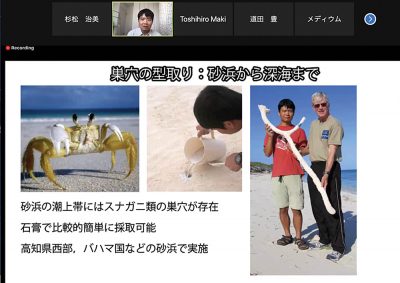
The 5th Underwater Technology Forum・ZERO was held online from 13:00 to 17:00 on 23rd April 2021, on the U-Tokyo Komaba Research Campus in Tokyo. As this is the third online forum since the one held on April 2020, we, organizers and participants, are getting familiar to the online meeting. Still, sometimes, technical issues such as the presentation slides getting stuck occur, however, it has become possible for people who live in a distance area can participate and give a lecture.
The topics of this forum are as follows;
- Impact of benthic burrows on marine environment
- Temperature rise and freezing delay mechanism in the Pacific Arctic Ocean
- Automatic classification of seafloor images by machine learning
- Development and operation of AUV by a private corporation –- Introduction of Tuna Sand class hovering type new AUV “YOUZAN”
- Special Session on IoT for Ocean Observation
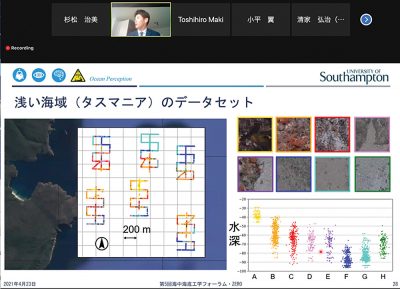
-Application of advanced Information and Communication technology to the ocean
-Wide area deployment of 5G/6G realized by stratosphere platform “HAPS” (unmanned solar aerial vehicle)
-Development of high-speed underwater acoustic communication tool (>600kbpsXkm) for deep sea exploration.
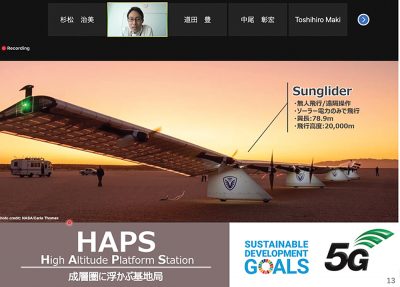
More than 280 people participated in the forum and enjoyed the discussions. The next forum will be held on October 8th. We are looking for the speakers from overseas (sorry for the time difference).
Malaysia Chapter
6th Annual General Meeting 2021
Reported by Mohd Shahrieel Mohd Aras & Zainah Md. Zain
The 6th IEEE OES Malaysia Chapter Annual General Meeting (AGM) was held on 30 January 2021 virtually via Google Meet. The 2020 chapter activities report was presented by the Chair, Dr. Khalid Isa. The chapter had conducted 15 administrative meetings, 22 educational activities, 7 technical activities, 1 membership drive, 1 proffesional activity, 1 social activity and 4 others. The AGM was then followed by the Treasurer’s report, which was presented by Assoc. Prof. Ir. Dr. Zool Hilmi Ismail. Next, the election for 2021/2022 IEEE OES Malaysia Chapter Executive Committees was conducted. The standing committees for 2021/2022 can be seen in the table below.
| 2021/2022 IEEE OES Malaysia Chapter Executive Committee | |
| Chair | Mohd Shahrieel Mohd Aras |
| Vice Chair | Zool Hilmi Ismail |
| Secretary | Zainah Md. Zain |
| Treasurer | Zulkifli Zainal Abidin |
| Excom |
Ahmad Faisal Mohamad Ayob Ahmad Anas Yusof Nur Afande Ali Hussain |
| Auditor |
Herdawatie Abdul Kadir Maziyah Mat Noh |
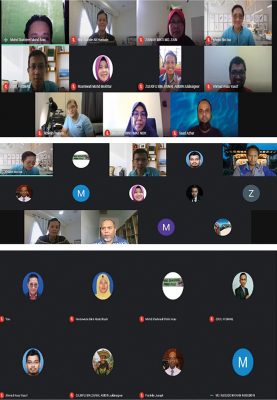
1st Technical Talk 2021: Modelling of Underwater Remotely Operated Vehicle for Depth Control
Reported by Zainah Md. Zain & Mohd Shahrieel Mohd Aras

Mohd Shahrieel Mohd Aras is an Associate Professor at the Mechatronic Department, Faculty of Electrical Engineering, UTEM. He is also a Chair of the IEEE OES Malaysia Chapter 2021/2022. His main area of interest focuses on Underwater research (Remotely Operated Underwater Vehicle, Underwater Glider, Autonomous Underwater Vehicle, Underwater Crawler), Artificial Intelligence (Fuzzy logic, Neural Network) System Identification, Control system, and PSO. This technical talk discussed on the modelling of underwater remotely operated vehicle for depth control, which included technical concepts and ideas that make it easier for others to contribute to OES projects. This talk was held on 6 May 2021, virtually in FB live at IEEE Oceanic Engineering Society – Malaysia Chapter as well as to promote the chapter.
Canadian Atlantic Chapter
Reported by Dr. Mae Seto, Chapter Chair
First, the Canadian Atlantic Section (CAS) wishes to acknowledge the recent passing of Dr. Ferial El-Hawary. Ferial was involved in founding the CAS OES Chapter and was deeply involved in many other activities in both OES and the Section for well over 30 years. She was an inspiration and mentor to many and will be deeply missed.
The Canadian Atlantic Chapter has held several events recently.
(1) Joint OES Events Hosted by East and West Coast Chapters in Canada
In December 2020, the Canadian Atlantic Section (CAS) and Vancouver Section Oceanic Engineering Chapters decided to jointly host a series of presentations. Although these chapters are separated by four time zones, they successfully held the events with great attendance!
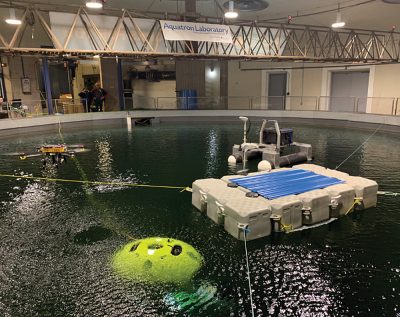
The first presentation was entitled “Multi-Domain Robot Collaboration Towards Situational Awareness on a Floating Target” (also jointly hosted by the CAS Robotics and Automation Society Chapter) by Dr. Mae Seto from Intelligent Systems Laboratory within Dalhousie University. This event provided an overview on a successful project between an east coast University and their industrial partner on the west coast, Cellula Robotics. This is a topic of particular interest to the Canadian Coast Guard and Department of National Defence (DND). It was attended by IEEE and non-IEEE members alike, from both the east and west coasts of Canada.

The second presentation was in February 2021 entitled “Can we really deploy thousands of lab-on-ship systems in marine environments” by Dr. Vincent Sieben from Dartmouth Ocean Technologies Inc. (Dartmouth, Nova Scotia). The presentation explored the emerging application of microfluidic devices to ocean sensing and its potential for measuring ocean-based environmental DNA and nutrients. The presentation was attended by a diverse group of engineering students, engineers from industry, chemists, defence contractors, and many more. For this event, once again, there were attendees from the east and west coasts of Canada.
A third event in this series is in the planning stage.
(2) On-line Career Fair for Undergraduate Engineers
On April 29, 2021, the CAS OES Chapter, Dalhousie University Student Branch and CAS Industry Relations Committee hosted an on-line job fair with three organizations (companies ranging from start-ups to multi-nationals) representing oceans/marine-based companies and a utilities company.
This event deliberately targeted undergraduate engineering students, both electrical and mechanical, who had just graduated, as well as those soon to graduate. This group has been especially impacted by the downturn in the economy due to the global pandemic. The main intent was to focus on the most junior engineers seeking opportunities.
Despite it being soon after the local universities’ winter term exams, there was still a good attendance at the event. The on-line career fair agenda was kept simple and focussed on the students. Each organization was given 5 minutes to talk about their organization. Then, the organizations went into their assigned breakout rooms. Each breakout room had an IEEE CAS member to assist with moderating questions from the students as needed. The students freely circulated through the 4 breakout rooms throughout the remainder of the event.
The industrial partners expressed gratitude for the opportunity to speak with interested students. They have related that online fairs give them the opportunity to talk to the most interested students first before considering their applications further.
Due to the global pandemic, both events were hosted as Zoom meetings. While in-person events are preferred, the on-line format facilitated participation across different time zones and made it possible for Chapters from different Sections to work together.


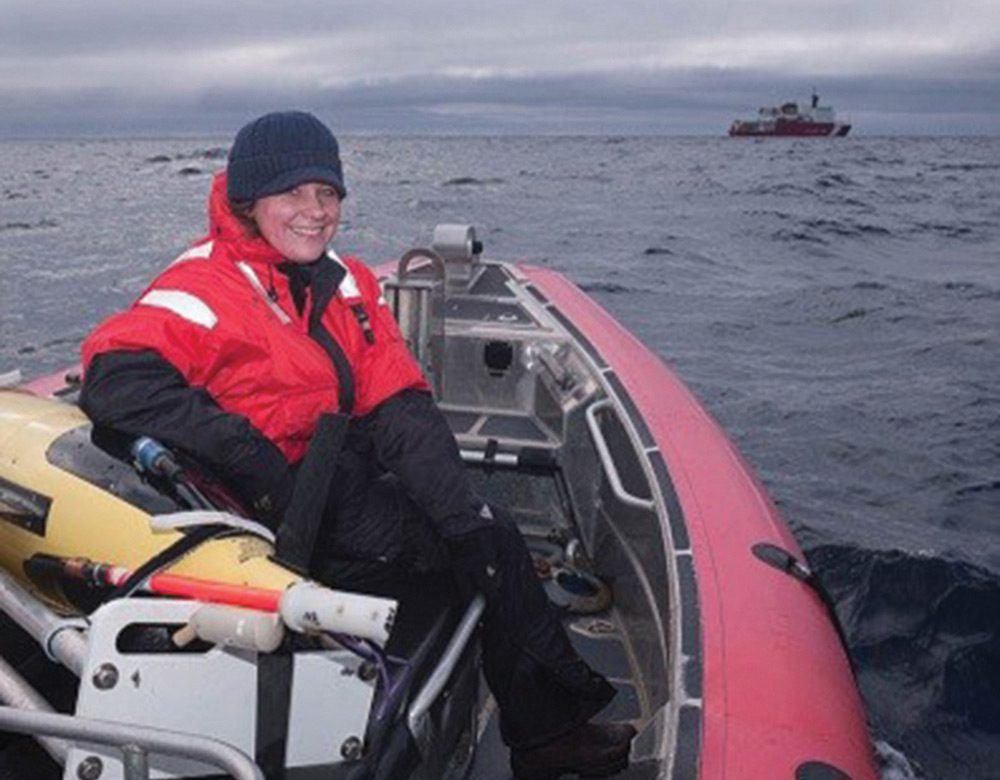
 Suleman Mazhar has been working as a professor in Information & Communication Engineering at Harbin Engineering University (China) since July 2019. He did PhD from Tokyo University (Japan) and postdoctorate from Georgetown University (Washington DC, USA). He had BS-CS from FAST-NUCES (Lahore) and MS from GIK Institute (Pakistan). He is TYSP young scientist fellow (Ministry of Science & Technology China) and have won several research grants from international organizations such as DAAD (Germany), ICIMOD (Nepal), NRPU (Higher Education Commission Pakistan), WWF (Worldwide Fund for Nature) Pakistan. His research focus is deep learning and signal processing applications for environmental monitoring, with particular focus on underwater acoustics, and marine mammal conservation. He is a reviewer for professional journals such as Journal of Acoustical Society (America), IEEE Journal of Oceanic Engineering, IEEE Sensors Journal, Applied Acoustics, IEEE Transactions on Intelligent Transportation Systems.
Suleman Mazhar has been working as a professor in Information & Communication Engineering at Harbin Engineering University (China) since July 2019. He did PhD from Tokyo University (Japan) and postdoctorate from Georgetown University (Washington DC, USA). He had BS-CS from FAST-NUCES (Lahore) and MS from GIK Institute (Pakistan). He is TYSP young scientist fellow (Ministry of Science & Technology China) and have won several research grants from international organizations such as DAAD (Germany), ICIMOD (Nepal), NRPU (Higher Education Commission Pakistan), WWF (Worldwide Fund for Nature) Pakistan. His research focus is deep learning and signal processing applications for environmental monitoring, with particular focus on underwater acoustics, and marine mammal conservation. He is a reviewer for professional journals such as Journal of Acoustical Society (America), IEEE Journal of Oceanic Engineering, IEEE Sensors Journal, Applied Acoustics, IEEE Transactions on Intelligent Transportation Systems. Peng Ren is a full professor with the College of Oceanography and Space Informatics, China University of Petroleum (East China). He is the director of Qingdao International Research Center for Intelligent Forecast and Detection of Oceanic Catastrophes. He received the K. M. Scott Prize from the University of York, the Natural Science award (first rank) from China Institute of Electronics, and the Eduardo Caianiello Best Student Paper Award from 18th International Conference on Image Analysis and Processing as one co-author. He has served as an associate editor of IEEE Transactions on Geoscience and Remote Sensing.
Peng Ren is a full professor with the College of Oceanography and Space Informatics, China University of Petroleum (East China). He is the director of Qingdao International Research Center for Intelligent Forecast and Detection of Oceanic Catastrophes. He received the K. M. Scott Prize from the University of York, the Natural Science award (first rank) from China Institute of Electronics, and the Eduardo Caianiello Best Student Paper Award from 18th International Conference on Image Analysis and Processing as one co-author. He has served as an associate editor of IEEE Transactions on Geoscience and Remote Sensing. Mohd Rizal Arshad is a full professor at the School of Electrical and Electronic Engineering at Universiti Sains Malaysia (USM), Malaysia, where he specializes in ocean robotics technology and intelligent system. He received his B.Eng. in Medical Electronics & Instrumentation and PhD in Electronic Engineering from University of Liverpool, UK in 1994 and 1999, respectively. He completed his MSc. in Electronic Control Engineering from the University of Salford, UK in Dec 1995. He has supervised many postgraduate students and published extensively in local and international publications. He is a senior member of the IEEE, and was awarded IEEE OES Presidential Award in 2019.
Mohd Rizal Arshad is a full professor at the School of Electrical and Electronic Engineering at Universiti Sains Malaysia (USM), Malaysia, where he specializes in ocean robotics technology and intelligent system. He received his B.Eng. in Medical Electronics & Instrumentation and PhD in Electronic Engineering from University of Liverpool, UK in 1994 and 1999, respectively. He completed his MSc. in Electronic Control Engineering from the University of Salford, UK in Dec 1995. He has supervised many postgraduate students and published extensively in local and international publications. He is a senior member of the IEEE, and was awarded IEEE OES Presidential Award in 2019. Itzik Klein is an Assistant Professor, heading the Autonomous Navigation and Sensor Fusion Lab, at the Charney School of Marine Sciences, Hatter Department of Marine Technologies, University of Haifa. He is an IEEE Senior Member and a member of the IEEE Journal of Indoor and Seamless Positioning and Navigation (J-ISPIN) Editorial Board. Prior to joining the University of Haifa, he worked at leading companies in Israel on navigation topics for more than 15 years. He has a wide range of experience in navigation systems and sensor fusion from both industry and academic perspectives. His research interests lie in the intersection of artificial intelligence with inertial sensing, sensor fusion, and autonomous underwater vehicles.
Itzik Klein is an Assistant Professor, heading the Autonomous Navigation and Sensor Fusion Lab, at the Charney School of Marine Sciences, Hatter Department of Marine Technologies, University of Haifa. He is an IEEE Senior Member and a member of the IEEE Journal of Indoor and Seamless Positioning and Navigation (J-ISPIN) Editorial Board. Prior to joining the University of Haifa, he worked at leading companies in Israel on navigation topics for more than 15 years. He has a wide range of experience in navigation systems and sensor fusion from both industry and academic perspectives. His research interests lie in the intersection of artificial intelligence with inertial sensing, sensor fusion, and autonomous underwater vehicles. John R. Potter (IEEE M’94, SM’02, F’18) graduated in the previous century with a joint honours Mathematics and Physics Degree from Bristol and a PhD. in Glaciology and Oceanography from Cambridge, UK studying Antarctic ice mass balance, where he spent four consecutive summers. This work helped underscore the non-linear fragility of polar ice to climate change and led to him receiving the Polar Medal from Queen Elizabeth II in 1988.
John R. Potter (IEEE M’94, SM’02, F’18) graduated in the previous century with a joint honours Mathematics and Physics Degree from Bristol and a PhD. in Glaciology and Oceanography from Cambridge, UK studying Antarctic ice mass balance, where he spent four consecutive summers. This work helped underscore the non-linear fragility of polar ice to climate change and led to him receiving the Polar Medal from Queen Elizabeth II in 1988. Nick is a Visiting Fellow at the UK National Oceanographic Center, Southampton His nomination was endorsed by the Underwater Acoustics Technology Committee. He had worked as a Research Associate and Lecturer at University of Birmingham and has been working as a Research Scientist at the Applied Research Laboratory, University of Texas, Austin. He has also served as a Program Officer at the Office of Naval Research Global. He is a senior member of IEEE (OES) and a Fellow of Acoustical Society of America (ASA). Nick has also been serving as Assoc. Editor for IEEE JoE and JASA. He is widely acknowledged for his expertise are seabed acoustics, parametric array modeling, sonar beamformer, underwater signal processing.
Nick is a Visiting Fellow at the UK National Oceanographic Center, Southampton His nomination was endorsed by the Underwater Acoustics Technology Committee. He had worked as a Research Associate and Lecturer at University of Birmingham and has been working as a Research Scientist at the Applied Research Laboratory, University of Texas, Austin. He has also served as a Program Officer at the Office of Naval Research Global. He is a senior member of IEEE (OES) and a Fellow of Acoustical Society of America (ASA). Nick has also been serving as Assoc. Editor for IEEE JoE and JASA. He is widely acknowledged for his expertise are seabed acoustics, parametric array modeling, sonar beamformer, underwater signal processing. Maurizio Migliaccio (M’91-SM’00-F’17) is Full professor of Electromagnetics at Università di Napoli Parthenope (Italy) and was Affiliated Full Professor at NOVA Southeastern University, Fort Lauderdale, FL (USA). He has been teaching Microwave Remote Sensing since 1994. He was visiting scientist at Deutsche Forschungsanstalt fur Lüft und Raumfahrt (DLR), Oberpfaffenhofen, Germany. He was member of the Italian Space Agency (ASI) scientific committee. He was member of the ASI CosmoSkyMed second generation panel. He was e-geos AdCom member. He was Italian delegate of the ESA PB-EO board. He was Member of South Africa Expert Review Panel for Space Exploration. He serves as reviewer for the UE, Italian Research Ministry (MIUR), NCST, Kazakhstan and Hong Kong Research board. He lectured in USA, Canada, Brazil, China, Hong Kong, Germany, Spain, Czech Republic, Switzerland and Italy. He was Italian delegate at UE COST SMOS Mode Action. He is listed in the Italian Top Scientists. He is an IEEE Trans. Geoscience and Remote Sensing AE, International Journal of Remote Sensing AE, and was IEEE Journal of Oceanic Engineering AE Special Issue on Radar for Marine and Maritime Remote Sensing, IEEE JSTARS AE of the Special Issue on CosmoSKyMed, Member of the Indian Journal of Radio & Space Physics Editorial board. His main current scientific interests cover SAR sea oil slick and man-made target monitoring, remote sensing for marine and coastal applications, remote sensing for agriculture monitoring, polarimetry, inverse problems for resolution enhancement, reverberating chambers. He published about 160 peer-reviewed journal papers on remote sensing and applied electromagnetics.
Maurizio Migliaccio (M’91-SM’00-F’17) is Full professor of Electromagnetics at Università di Napoli Parthenope (Italy) and was Affiliated Full Professor at NOVA Southeastern University, Fort Lauderdale, FL (USA). He has been teaching Microwave Remote Sensing since 1994. He was visiting scientist at Deutsche Forschungsanstalt fur Lüft und Raumfahrt (DLR), Oberpfaffenhofen, Germany. He was member of the Italian Space Agency (ASI) scientific committee. He was member of the ASI CosmoSkyMed second generation panel. He was e-geos AdCom member. He was Italian delegate of the ESA PB-EO board. He was Member of South Africa Expert Review Panel for Space Exploration. He serves as reviewer for the UE, Italian Research Ministry (MIUR), NCST, Kazakhstan and Hong Kong Research board. He lectured in USA, Canada, Brazil, China, Hong Kong, Germany, Spain, Czech Republic, Switzerland and Italy. He was Italian delegate at UE COST SMOS Mode Action. He is listed in the Italian Top Scientists. He is an IEEE Trans. Geoscience and Remote Sensing AE, International Journal of Remote Sensing AE, and was IEEE Journal of Oceanic Engineering AE Special Issue on Radar for Marine and Maritime Remote Sensing, IEEE JSTARS AE of the Special Issue on CosmoSKyMed, Member of the Indian Journal of Radio & Space Physics Editorial board. His main current scientific interests cover SAR sea oil slick and man-made target monitoring, remote sensing for marine and coastal applications, remote sensing for agriculture monitoring, polarimetry, inverse problems for resolution enhancement, reverberating chambers. He published about 160 peer-reviewed journal papers on remote sensing and applied electromagnetics. He has developed various types of Autonomous Underwater Vehicles (AUVs) and related application technologies including navigation methods, a new sensing method using a chemical sensor, precise seafloor mapping methods, a precise seabed positioning system with a resolution of a few centimeters, a new sensing system of the thickness of cobalt-rich crust; and more. He has shown, by using these technologies that AUVs are practicable and valuable tools for deep-sea exploration.
He has developed various types of Autonomous Underwater Vehicles (AUVs) and related application technologies including navigation methods, a new sensing method using a chemical sensor, precise seafloor mapping methods, a precise seabed positioning system with a resolution of a few centimeters, a new sensing system of the thickness of cobalt-rich crust; and more. He has shown, by using these technologies that AUVs are practicable and valuable tools for deep-sea exploration. Donna Kocak has had an outstanding career in defense and scientific projects developing and applying solutions in subsea optics, imaging and robotics. She graduated with an M.Sc in Computer Science in 1997 from the University of Central Florida; an MBA in 2008 from the University of Florida; and M.Sc in Industrial Engineering in 2011 from the University of Central Florida. She is currently a Senior Scientist, Advanced Concepts Engineering, and Fellow at the Harris Corporation in Melbourne, Florida, where she has developed novel optical imaging and communication solutions for under-sea defense and scientific projects. Prior to 2008 Donna Kocak was Founder and President of Green Sky Imaging, LLC (GSI) who developed laser/video photogrammetry software for underwater inspection and survey. Her earlier career positions were with Naval Training Systems Center, Florida; Harbor Branch Oceanographic Institution, Florida; eMerge Interactive; and the Advanced Technologies Group in Florida.
Donna Kocak has had an outstanding career in defense and scientific projects developing and applying solutions in subsea optics, imaging and robotics. She graduated with an M.Sc in Computer Science in 1997 from the University of Central Florida; an MBA in 2008 from the University of Florida; and M.Sc in Industrial Engineering in 2011 from the University of Central Florida. She is currently a Senior Scientist, Advanced Concepts Engineering, and Fellow at the Harris Corporation in Melbourne, Florida, where she has developed novel optical imaging and communication solutions for under-sea defense and scientific projects. Prior to 2008 Donna Kocak was Founder and President of Green Sky Imaging, LLC (GSI) who developed laser/video photogrammetry software for underwater inspection and survey. Her earlier career positions were with Naval Training Systems Center, Florida; Harbor Branch Oceanographic Institution, Florida; eMerge Interactive; and the Advanced Technologies Group in Florida. John Potter has a Joint Honours degree in Mathematics and Physics from Bristol University in the UK and a PhD in Glaciology and Oceanography from the University of Cambridge on research in the Antarctic, for which he was awarded the Polar Medal in 1988. John has worked on polar oceanography, underwater acoustics, ambient noise (including imaging), marine mammals, communications, IoUT, autonomous vehicles and strategic development. He has 40 years’ international experience working at the British Antarctic Survey in the UK, NATO in Italy, SIO in California, NUS in Singapore and most recently at NTNU in Norway. John is a Fellow of the IEEE and MTS, an Associate Editor for the IEEE Journal of Oceanic Engineering, IEEE OES Distinguished Lecturer, PADI Master Scuba Diver Trainer & an International Fellow of the Explorer’s Club.
John Potter has a Joint Honours degree in Mathematics and Physics from Bristol University in the UK and a PhD in Glaciology and Oceanography from the University of Cambridge on research in the Antarctic, for which he was awarded the Polar Medal in 1988. John has worked on polar oceanography, underwater acoustics, ambient noise (including imaging), marine mammals, communications, IoUT, autonomous vehicles and strategic development. He has 40 years’ international experience working at the British Antarctic Survey in the UK, NATO in Italy, SIO in California, NUS in Singapore and most recently at NTNU in Norway. John is a Fellow of the IEEE and MTS, an Associate Editor for the IEEE Journal of Oceanic Engineering, IEEE OES Distinguished Lecturer, PADI Master Scuba Diver Trainer & an International Fellow of the Explorer’s Club. Dr. James V. Candy is the Chief Scientist for Engineering and former Director of the Center for Advanced Signal & Image Sciences at the University of California, Lawrence Livermore National Laboratory. Dr. Candy received a commission in the USAF in 1967 and was a Systems Engineer/Test Director from 1967 to 1971. He has been a Researcher at the Lawrence Livermore National Laboratory since 1976 holding various positions including that of Project Engineer for Signal Processing and Thrust Area Leader for Signal and Control Engineering. Educationally, he received his B.S.E.E. degree from the University of Cincinnati and his M.S.E. and Ph.D. degrees in Electrical Engineering from the University of Florida, Gainesville. He is a registered Control System Engineer in the state of California. He has been an Adjunct Professor at San Francisco State University, University of Santa Clara, and UC Berkeley, Extension teaching graduate courses in signal and image processing. He is an Adjunct Full-Professor at the University of California, Santa Barbara. Dr. Candy is a Fellow of the IEEE and a Fellow of the Acoustical Society of America (ASA) and elected as a Life Member (Fellow) at the University of Cambridge (Clare Hall College). He is a member of Eta Kappa Nu and Phi Kappa Phi honorary societies. He was elected as a Distinguished Alumnus by the University of Cincinnati. Dr. Candy received the IEEE Distinguished Technical Achievement Award for the “development of model-based signal processing in ocean acoustics.” Dr. Candy was selected as a IEEE Distinguished Lecturer for oceanic signal processing as well as presenting an IEEE tutorial on advanced signal processing available through their video website courses. He was nominated for the prestigious Edward Teller Fellowship at Lawrence Livermore National Laboratory. Dr. Candy was awarded the Interdisciplinary Helmholtz-Rayleigh Silver Medal in Signal Processing/Underwater Acoustics by the Acoustical Society of America for his technical contributions. He has published over 225 journal articles, book chapters, and technical reports as well as written three texts in signal processing, “Signal Processing: the Model-Based Approach,” (McGraw-Hill, 1986), “Signal Processing: the Modern Approach,” (McGraw-Hill, 1988), “Model-Based Signal Processing,” (Wiley/IEEE Press, 2006) and “Bayesian Signal Processing: Classical, Modern and Particle Filtering” (Wiley/IEEE Press, 2009). He was the General Chairman of the inaugural 2006 IEEE Nonlinear Statistical Signal Processing Workshop held at the Corpus Christi College, University of Cambridge. He has presented a variety of short courses and tutorials sponsored by the IEEE and ASA in Applied Signal Processing, Spectral Estimation, Advanced Digital Signal Processing, Applied Model-Based Signal Processing, Applied Acoustical Signal Processing, Model-Based Ocean Acoustic Signal Processing and Bayesian Signal Processing for IEEE Oceanic Engineering Society/ASA. He has also presented short courses in Applied Model-Based Signal Processing for the SPIE Optical Society. He is currently the IEEE Chair of the Technical Committee on “Sonar Signal and Image Processing” and was the Chair of the ASA Technical Committee on “Signal Processing in Acoustics” as well as being an Associate Editor for Signal Processing of ASA (on-line JASAXL). He was recently nominated for the Vice Presidency of the ASA and elected as a member of the Administrative Committee of IEEE OES. His research interests include Bayesian estimation, identification, spatial estimation, signal and image processing, array signal processing, nonlinear signal processing, tomography, sonar/radar processing and biomedical applications.
Dr. James V. Candy is the Chief Scientist for Engineering and former Director of the Center for Advanced Signal & Image Sciences at the University of California, Lawrence Livermore National Laboratory. Dr. Candy received a commission in the USAF in 1967 and was a Systems Engineer/Test Director from 1967 to 1971. He has been a Researcher at the Lawrence Livermore National Laboratory since 1976 holding various positions including that of Project Engineer for Signal Processing and Thrust Area Leader for Signal and Control Engineering. Educationally, he received his B.S.E.E. degree from the University of Cincinnati and his M.S.E. and Ph.D. degrees in Electrical Engineering from the University of Florida, Gainesville. He is a registered Control System Engineer in the state of California. He has been an Adjunct Professor at San Francisco State University, University of Santa Clara, and UC Berkeley, Extension teaching graduate courses in signal and image processing. He is an Adjunct Full-Professor at the University of California, Santa Barbara. Dr. Candy is a Fellow of the IEEE and a Fellow of the Acoustical Society of America (ASA) and elected as a Life Member (Fellow) at the University of Cambridge (Clare Hall College). He is a member of Eta Kappa Nu and Phi Kappa Phi honorary societies. He was elected as a Distinguished Alumnus by the University of Cincinnati. Dr. Candy received the IEEE Distinguished Technical Achievement Award for the “development of model-based signal processing in ocean acoustics.” Dr. Candy was selected as a IEEE Distinguished Lecturer for oceanic signal processing as well as presenting an IEEE tutorial on advanced signal processing available through their video website courses. He was nominated for the prestigious Edward Teller Fellowship at Lawrence Livermore National Laboratory. Dr. Candy was awarded the Interdisciplinary Helmholtz-Rayleigh Silver Medal in Signal Processing/Underwater Acoustics by the Acoustical Society of America for his technical contributions. He has published over 225 journal articles, book chapters, and technical reports as well as written three texts in signal processing, “Signal Processing: the Model-Based Approach,” (McGraw-Hill, 1986), “Signal Processing: the Modern Approach,” (McGraw-Hill, 1988), “Model-Based Signal Processing,” (Wiley/IEEE Press, 2006) and “Bayesian Signal Processing: Classical, Modern and Particle Filtering” (Wiley/IEEE Press, 2009). He was the General Chairman of the inaugural 2006 IEEE Nonlinear Statistical Signal Processing Workshop held at the Corpus Christi College, University of Cambridge. He has presented a variety of short courses and tutorials sponsored by the IEEE and ASA in Applied Signal Processing, Spectral Estimation, Advanced Digital Signal Processing, Applied Model-Based Signal Processing, Applied Acoustical Signal Processing, Model-Based Ocean Acoustic Signal Processing and Bayesian Signal Processing for IEEE Oceanic Engineering Society/ASA. He has also presented short courses in Applied Model-Based Signal Processing for the SPIE Optical Society. He is currently the IEEE Chair of the Technical Committee on “Sonar Signal and Image Processing” and was the Chair of the ASA Technical Committee on “Signal Processing in Acoustics” as well as being an Associate Editor for Signal Processing of ASA (on-line JASAXL). He was recently nominated for the Vice Presidency of the ASA and elected as a member of the Administrative Committee of IEEE OES. His research interests include Bayesian estimation, identification, spatial estimation, signal and image processing, array signal processing, nonlinear signal processing, tomography, sonar/radar processing and biomedical applications. Kenneth Foote is a Senior Scientist at the Woods Hole Oceanographic Institution. He received a B.S. in Electrical Engineering from The George Washington University in 1968, and a Ph.D. in Physics from Brown University in 1973. He was an engineer at Raytheon Company, 1968-1974; postdoctoral scholar at Loughborough University of Technology, 1974-1975; research fellow and substitute lecturer at the University of Bergen, 1975-1981. He began working at the Institute of Marine Research, Bergen, in 1979; joined the Woods Hole Oceanographic Institution in 1999. His general area of expertise is in underwater sound scattering, with applications to the quantification of fish, other aquatic organisms, and physical scatterers in the water column and on the seafloor. In developing and transitioning acoustic methods and instruments to operations at sea, he has worked from 77°N to 55°S.
Kenneth Foote is a Senior Scientist at the Woods Hole Oceanographic Institution. He received a B.S. in Electrical Engineering from The George Washington University in 1968, and a Ph.D. in Physics from Brown University in 1973. He was an engineer at Raytheon Company, 1968-1974; postdoctoral scholar at Loughborough University of Technology, 1974-1975; research fellow and substitute lecturer at the University of Bergen, 1975-1981. He began working at the Institute of Marine Research, Bergen, in 1979; joined the Woods Hole Oceanographic Institution in 1999. His general area of expertise is in underwater sound scattering, with applications to the quantification of fish, other aquatic organisms, and physical scatterers in the water column and on the seafloor. In developing and transitioning acoustic methods and instruments to operations at sea, he has worked from 77°N to 55°S. René Garello, professor at Télécom Bretagne, Fellow IEEE, co-leader of the TOMS (Traitements, Observations et Méthodes Statistiques) research team, in Pôle CID of the UMR CNRS 3192 Lab-STICC.
René Garello, professor at Télécom Bretagne, Fellow IEEE, co-leader of the TOMS (Traitements, Observations et Méthodes Statistiques) research team, in Pôle CID of the UMR CNRS 3192 Lab-STICC. Professor Mal Heron is Adjunct Professor in the Marine Geophysical Laboratory at James Cook University in Townsville, Australia, and is CEO of Portmap Remote Ocean Sensing Pty Ltd. His PhD work in Auckland, New Zealand, was on radio-wave probing of the ionosphere, and that is reflected in his early ionospheric papers. He changed research fields to the scattering of HF radio waves from the ocean surface during the 1980s. Through the 1990s his research has broadened into oceanographic phenomena which can be studied by remote sensing, including HF radar and salinity mapping from airborne microwave radiometers . Throughout, there have been one-off papers where he has been involved in solving a problem in a cognate area like medical physics, and paleobiogeography. Occasionally, he has diverted into side-tracks like a burst of papers on the effect of bushfires on radio communications. His present project of the Australian Coastal Ocean Radar Network (ACORN) is about the development of new processing methods and applications of HF radar data to address oceanography problems. He is currently promoting the use of high resolution VHF ocean radars, based on the PortMap high resolution radar.
Professor Mal Heron is Adjunct Professor in the Marine Geophysical Laboratory at James Cook University in Townsville, Australia, and is CEO of Portmap Remote Ocean Sensing Pty Ltd. His PhD work in Auckland, New Zealand, was on radio-wave probing of the ionosphere, and that is reflected in his early ionospheric papers. He changed research fields to the scattering of HF radio waves from the ocean surface during the 1980s. Through the 1990s his research has broadened into oceanographic phenomena which can be studied by remote sensing, including HF radar and salinity mapping from airborne microwave radiometers . Throughout, there have been one-off papers where he has been involved in solving a problem in a cognate area like medical physics, and paleobiogeography. Occasionally, he has diverted into side-tracks like a burst of papers on the effect of bushfires on radio communications. His present project of the Australian Coastal Ocean Radar Network (ACORN) is about the development of new processing methods and applications of HF radar data to address oceanography problems. He is currently promoting the use of high resolution VHF ocean radars, based on the PortMap high resolution radar. Hanu Singh graduated B.S. ECE and Computer Science (1989) from George Mason University and Ph.D. (1995) from MIT/Woods Hole.He led the development and commercialization of the Seabed AUV, nine of which are in operation at other universities and government laboratories around the world. He was technical lead for development and operations for Polar AUVs (Jaguar and Puma) and towed vehicles(Camper and Seasled), and the development and commercialization of the Jetyak ASVs, 18 of which are currently in use. He was involved in the development of UAS for polar and oceanographic applications, and high resolution multi-sensor acoustic and optical mapping with underwater vehicles on over 55 oceanographic cruises in support of physical oceanography, marine archaeology, biology, fisheries, coral reef studies, geology and geophysics and sea-ice studies. He is an accomplished Research Student advisor and has made strong collaborations across the US (including at MIT, SIO, Stanford, Columbia LDEO) and internationally including in the UK, Australia, Canada, Korea, Taiwan, China, Japan, India, Sweden and Norway. Hanu Singh is currently Chair of the IEEE Ocean Engineering Technology Committee on Autonomous Marine Systems with responsibilities that include organizing the biennial IEEE AUV Conference, 2008 onwards. Associate Editor, IEEE Journal of Oceanic Engineering, 2007-2011. Associate editor, Journal of Field Robotics 2012 onwards.
Hanu Singh graduated B.S. ECE and Computer Science (1989) from George Mason University and Ph.D. (1995) from MIT/Woods Hole.He led the development and commercialization of the Seabed AUV, nine of which are in operation at other universities and government laboratories around the world. He was technical lead for development and operations for Polar AUVs (Jaguar and Puma) and towed vehicles(Camper and Seasled), and the development and commercialization of the Jetyak ASVs, 18 of which are currently in use. He was involved in the development of UAS for polar and oceanographic applications, and high resolution multi-sensor acoustic and optical mapping with underwater vehicles on over 55 oceanographic cruises in support of physical oceanography, marine archaeology, biology, fisheries, coral reef studies, geology and geophysics and sea-ice studies. He is an accomplished Research Student advisor and has made strong collaborations across the US (including at MIT, SIO, Stanford, Columbia LDEO) and internationally including in the UK, Australia, Canada, Korea, Taiwan, China, Japan, India, Sweden and Norway. Hanu Singh is currently Chair of the IEEE Ocean Engineering Technology Committee on Autonomous Marine Systems with responsibilities that include organizing the biennial IEEE AUV Conference, 2008 onwards. Associate Editor, IEEE Journal of Oceanic Engineering, 2007-2011. Associate editor, Journal of Field Robotics 2012 onwards. Milica Stojanovic graduated from the University of Belgrade, Serbia, in 1988, and received the M.S. and Ph.D. degrees in electrical engineering from Northeastern University in Boston, in 1991 and 1993. She was a Principal Scientist at the Massachusetts Institute of Technology, and in 2008 joined Northeastern University, where she is currently a Professor of electrical and computer engineering. She is also a Guest Investigator at the Woods Hole Oceanographic Institution. Milica’s research interests include digital communications theory, statistical signal processing and wireless networks, and their applications to underwater acoustic systems. She has made pioneering contributions to underwater acoustic communications, and her work has been widely cited. She is a Fellow of the IEEE, and serves as an Associate Editor for its Journal of Oceanic Engineering (and in the past for Transactions on Signal Processing and Transactions on Vehicular Technology). She also serves on the Advisory Board of the IEEE Communication Letters, and chairs the IEEE Ocean Engineering Society’s Technical Committee for Underwater Communication, Navigation and Positioning. Milica is the recipient of the 2015 IEEE/OES Distinguished Technical Achievement Award.
Milica Stojanovic graduated from the University of Belgrade, Serbia, in 1988, and received the M.S. and Ph.D. degrees in electrical engineering from Northeastern University in Boston, in 1991 and 1993. She was a Principal Scientist at the Massachusetts Institute of Technology, and in 2008 joined Northeastern University, where she is currently a Professor of electrical and computer engineering. She is also a Guest Investigator at the Woods Hole Oceanographic Institution. Milica’s research interests include digital communications theory, statistical signal processing and wireless networks, and their applications to underwater acoustic systems. She has made pioneering contributions to underwater acoustic communications, and her work has been widely cited. She is a Fellow of the IEEE, and serves as an Associate Editor for its Journal of Oceanic Engineering (and in the past for Transactions on Signal Processing and Transactions on Vehicular Technology). She also serves on the Advisory Board of the IEEE Communication Letters, and chairs the IEEE Ocean Engineering Society’s Technical Committee for Underwater Communication, Navigation and Positioning. Milica is the recipient of the 2015 IEEE/OES Distinguished Technical Achievement Award. Dr. Paul C. Hines was born and raised in Glace Bay, Cape Breton. From 1977-1981 he attended Dalhousie University, Halifax, Nova Scotia, graduating with a B.Sc. (Hon) in Engineering-Physics.
Dr. Paul C. Hines was born and raised in Glace Bay, Cape Breton. From 1977-1981 he attended Dalhousie University, Halifax, Nova Scotia, graduating with a B.Sc. (Hon) in Engineering-Physics.